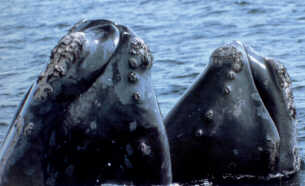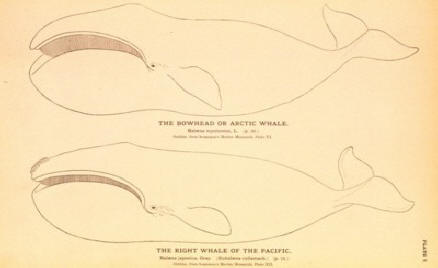
|
|
|
THE DISAPPEARANCE OF THE NORTHERN RIGHT WHALE With a population estimated at around 300 individuals, the northern right whale is “the most endangered species.” And unfortunately, they appear to be in very serious trouble. Once they were fairly abundant, but this creature’s first bit of bad luck was to be designated as the “right” whale by the early
whalers...meaning "right" to kill. Apparently it moves more slowly than other
whales and conveniently floats after death - sinking whale corpses presented a
real problem to the early whalers. Because of this, the right whale suffered
heavy losses from “whaling pressure” earlier than most. The right whale was
relatively rare even a century ago. The northern right whale has been protected
by an international agreement since 1935. Since that time the population has
failed to grow significantly, in fact it now appears to be in further decline.
(Population: approximately 300 whales) It is very disappointing to see this rare
animal fail to increase it’s numbers despite our best efforts to “protect” it.
In the last decade considerable effort has been put into trying to “save”
the right whale. Collisions with ships are believed to be one of the major
threats facing these whales, so systematic aerial surveys are done to
determine where the whales are swimming and then shipping traffic is warned to
stay clear of them. This is probably a worthwhile venture, but will never be
enough. The crew of the survey planes keep good records of dates and
numbers, and write up reports which are posted on the internet. (http://whale.wheelock.edu/whalenet-stuff/reports/
) They have sighted very
few calves in the past few years, and considering how few calves they see, it
is actually not uncommon for them to report dead ones (causes of death for
the calves have been unclear - usually not “ship-strikes” or “entanglement in
fishing gear”). "What" is killing the right whale calves? It is not understood, and it is not all down to "pollution."
Why is the right whale having so much trouble? Why is it’s
reproductive success so very low? The threats of ship strikes and fishing gear
entanglement should not prevent pregnancy in the majority of whales who manage to avoid them.
Why is there such a contrast between the lack of success of the right whale
and the relatively better success (increased populations) of other protected
baleen whales such as the gray whale and the humpback? (If the problem was due to a "polluted" ocean, should not the others be suffering just as much?) whale by the early
whalers...meaning "right" to kill. Apparently it moves more slowly than other
whales and conveniently floats after death - sinking whale corpses presented a
real problem to the early whalers. Because of this, the right whale suffered
heavy losses from “whaling pressure” earlier than most. The right whale was
relatively rare even a century ago. The northern right whale has been protected
by an international agreement since 1935. Since that time the population has
failed to grow significantly, in fact it now appears to be in further decline.
(Population: approximately 300 whales) It is very disappointing to see this rare
animal fail to increase it’s numbers despite our best efforts to “protect” it.
In the last decade considerable effort has been put into trying to “save”
the right whale. Collisions with ships are believed to be one of the major
threats facing these whales, so systematic aerial surveys are done to
determine where the whales are swimming and then shipping traffic is warned to
stay clear of them. This is probably a worthwhile venture, but will never be
enough. The crew of the survey planes keep good records of dates and
numbers, and write up reports which are posted on the internet. (http://whale.wheelock.edu/whalenet-stuff/reports/
) They have sighted very
few calves in the past few years, and considering how few calves they see, it
is actually not uncommon for them to report dead ones (causes of death for
the calves have been unclear - usually not “ship-strikes” or “entanglement in
fishing gear”). "What" is killing the right whale calves? It is not understood, and it is not all down to "pollution."
Why is the right whale having so much trouble? Why is it’s
reproductive success so very low? The threats of ship strikes and fishing gear
entanglement should not prevent pregnancy in the majority of whales who manage to avoid them.
Why is there such a contrast between the lack of success of the right whale
and the relatively better success (increased populations) of other protected
baleen whales such as the gray whale and the humpback? (If the problem was due to a "polluted" ocean, should not the others be suffering just as much?)I think that the reason why the right whale is faring so much worse than the others lies in the nature of the beast itself. It is because the right whale is much more limited in its feeding options than the others. Compared to the others it has very long and FINE baleen. This type of baleen essentially only “catches” PLANKTON (the really little stuff). Humpbacks and the other baleen whales ("rorquals") are built differently, they can swim faster, chase schools of small fish, take a huge gulp with their distendable throat and trap the little fish in their relatively shorter and stiffer baleen. The right whale cannot do this. He must survive by straining the plankton out of the water, and that is it. The severely limited feeding option of the right whale is it’s fatal flaw - if plankton levels decline, this whale is in serious trouble. (Only the bowhead whale is built along the same lines as the right whale, and that one is severely endangered as well.) Sixty-five years relief from “whaling pressure,” essentially no natural predators, an animal that matures between 5 and 8 years of age, one that is supposedly capable of producing a calf every three years...with numbers like that, the right whale population should have made a comeback over the last six decades. But it has not. The right whale’s large size has worked against it - smaller plankton feeders are more capable of surviving in conditions with less plankton. To grow so large, and to survive by filter-feeding, is a relatively unusual thing. The right whale obviously evolved when there were “lush plankton forests” and, by growing so large, was always “pushing the envelope” for a plankton feeder. It is probably the single most sensitive animal in the sea to a drop in the concentration of plankton. Therefore it seems to me that the right whale makes a very useful “plankton index.” It is a bit like a thermometer to gauge the “health” of the marine ecosystem. The right whale can also easily be compared to the “canary in a coal mine.” When the environment gets hazardous to life, the canary will die first and warn the miners of the danger... Living conditions in the ocean are all but impossible for the northern right whale today. I believe these whales are suffering badly from starvation, and have been doing so for a long time. If you look for other large specialized plankton feeders for comparison, for example the whale shark and the basking shark, where do you find them?...beside the right whale...on the endangered species lists... These are all pieces of the puzzle that make up the picture of the STARVING MARINE ECOSYSTEM.  Illustration, and photo at top of page - NOAA
Illustration, and photo at top of page - NOAA
|